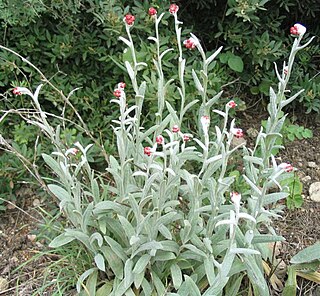
The genus Helichrysum consists of an estimated 600 species of flowering plants in the sunflower family (Asteraceae). The type species is Helichrysum orientale. They often go by the names everlasting, immortelle, and strawflower. The name is derived from the Ancient Greek words ἥλιος and χρῡσός.

Helichrysum sanguineum, known in English as red everlasting and red cudweed, is a flowering plant of the genus Helichrysum in the family Asteraceae. It grows in mountain forests in the Levant where it blooms in April–June. The flower, known in Hebrew as "Blood of the Maccabees", has become the icon of Yom Hazikaron, Memorial Day for Israel's Fallen Soldiers and Victims of Terrorism.
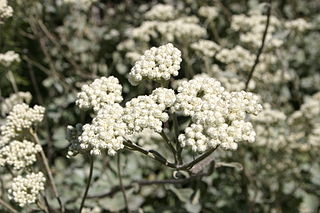
Helichrysum petiolare, the licorice-plant or liquorice plant, is a species of flowering plant in the family Asteraceae. It is a subshrub native to the Cape Provinces of South Africa — where it is known as imphepho — and to Angola, Zambia, and Zimbabwe. It is naturalized in parts of Portugal and the United States. Growing to about 45 cm (18 in) high and 150 cm (59 in) broad, it is a trailing evergreen subshrub with furry grey-green leaves and small white flowers. Other common names include silver-bush everlastingflower, trailing dusty miller and kooigoed. The foliage has a faint licorice aroma, but Helichrysum petiolare is not closely related to the true liquorice plant, Glycyrrhiza glabra.

Helichrysum italicum is a species of flowering plant in the family Asteraceae. It is sometimes called the curry plant because of the strong fragrance of its leaves. Other common names include Italian strawflower and immortelle. It grows on dry, rocky or sandy ground around the Mediterranean. The stems are woody at the base and can reach 60 centimetres (24 in) or more in height. The clusters of yellow flowers are produced in summer, they retain their colour after picking and are used in dried flower arrangements.
The Cosmopterigidae are a family of insects in the order Lepidoptera. These are small moths with narrow wings whose tiny larvae feed internally on the leaves, seeds and stems of their host plants. About 1500 species are described. The taxonomic family is most diverse in the Australian and Pacific region with about 780 species.
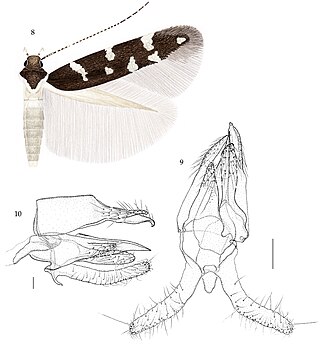
Vulcaniella kabulensis is a moth of the family Cosmopterigidae. It is endemic to Afghanistan.

Pseudognaphalium luteoalbum, synonyms including Helichrysum luteoalbum, is a species of flowering plant in the family Asteraceae. In the United Kingdom, it is known as the Jersey cudweed.

Vulcaniella is a genus of moths in the family Cosmopterigidae, containing the following species:

Eublemma minutata, the scarce marbled, is a species of moth of the family Erebidae. It can be found everywhere in Europe, except for Luxembourg, the Netherlands, the northern part of Russia and various islands. In Asia, it can be found only in Lebanon.
Vulcaniella extremella is a moth of the family Cosmopterigidae. It is found from Poland to the Iberian Peninsula, Italy, and Bulgaria and from France to central and southern Russia.
Vulcaniella grabowiella is a moth of the family Cosmopterigidae. It is found from the Iberian Peninsula to Asia Minor.
Vulcaniella pomposella is a moth of the family Cosmopterigidae. It is found from France, the Baltic Region and Ukraine to the Mediterranean region.
Vulcaniella rosmarinella is a moth of the family Cosmopterigidae. It is found in the area surrounding the Mediterranean Sea, as far east as Crete. It is also found in North Africa.
Vulcaniella grandiferella is a moth of the family Cosmopterigidae. It is found in Serbia, Macedonia, Greece, Ukraine and southern Russia.
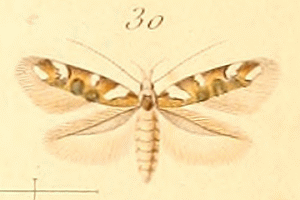
Isidiella divitella is a moth in the family Cosmopterigidae. It is found in France, on the Iberian Peninsula, Corsica and Sardinia.
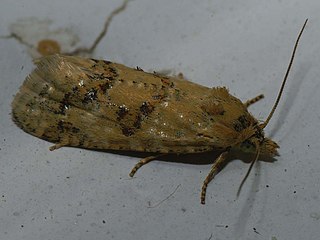
Aethes williana, the silver carrot conch, is a species of moth of the family Tortricidae. It was described by Nikolaus Joseph Brahm in 1791. It is found in most of Europe, Trans-Caspia, Asia Minor, Mongolia, north-western Africa and Iran. It is found in dry, sandy and chalky habitats.

Aethes languidana is a species of moth of the family Tortricidae. It was described by Josef Johann Mann in 1855. It is found in France, Spain, Portugal and Italy and on Corsica and Sardinia.
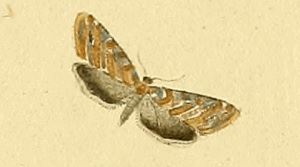
Eupoecilia cebrana is a species of moth of the family Tortricidae. It is found in Sweden, France, Germany, Denmark, Poland, Austria, Slovakia, Estonia, Latvia, Lithuania, Russia, North Macedonia and Greece.
Epiphyas oresigona is a species of moth of the family Tortricidae. It is found in Australia, where it has been recorded from Tasmania. The habitat consists of alpine heathland.

Helichrysum splendidum is a species of flowering plant in the family Asteraceae, found in Africa and Yemen A hardy evergreen perennial, it occurs from the Southern Cape to Ethiopia along the eastern escarpment mountains, favouring rocky places in fynbos, grassland and savanna biomes. It forms mound-shaped aggregations 1–2 meters high, sometimes covering entire hillsides. The species is found in South Africa, Eswatini, Lesotho, Tanzania, Ethiopia, South Sudan, Malawi, Zimbabwe, Zambia and Yemen. The distribution of this species is clearly anthropogenic, that is, closely linked to the movements of man through the ages.











